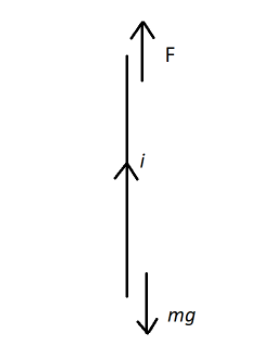Question
Question: A straight wire of mass \(200\;{\text{g}}\) and length \(1.5\;{\text{m}}\) carries a current of \(2\...
A straight wire of mass 200g and length 1.5m carries a current of 2A. It is suspended in mid-air by a uniform horizontal magnetic field B. The magnitude of B (in tesla) is:
(A) 0.65
(B) 0.55
(C) 0.75
(D) 0.45
Solution
As we can all see, the force acting under a uniform magnetic field on a current-carrying wire is equal to the weight of the wire because the wire is in equilibrium and has no acceleration, so it does not move.
Formula Used: We will be using the following formula,
F=BiLsinθ
Where
F is the force due to the magnetic field
B is the magnitude of the magnetic field
i is the current carrying in the wire
L is the length of the wire
θ in the angle between magnetic field and current
Complete Step-by-Step solution:
The following information is provided to us in the given question:
The mass of the wire, m=200g=0.2kg
The length of the wire, l=15m
The current flowing through the wire, i=2A
And we have to find out the magnetic field
Let us draw the stick figure of the wire given in the question and mention all the forces acting on it

Now, we can see that the direction of current is perpendicular to the magnetic field horizontally, hence the angle
θ=90∘
We know that
F=BiLsinθ
Since, θ=90∘, we have sin90∘=1
So,
F=BiL
Now the weight of the wire is given by w=mg
That is w=0.2×9.8N
According to the figure,
F=mg
Now, let us substitute the known values in the formula to get
BiL=mg
Rearranging the terms, we have
B=iLmg
Let us now substitute the values
B=2×150.2×9.8
So, we get
∴B=0.65T
Hence, the correct option is (A.)
Note: We all learned that the left-hand rule of Fleming is used to describe the force placed at right angles to a magnetic field on a current-carrying conductor. The conductor carrying the current should be made of ferromagnetic material.
